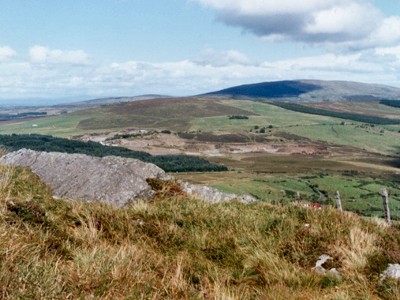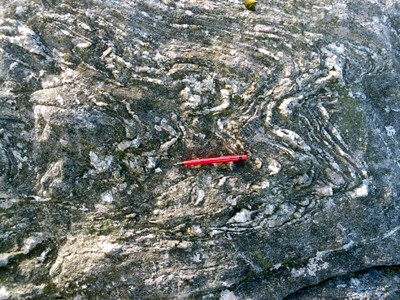Earth Science Conservation Review
| Oughtmore Mountain - PreCambrian | Tyrone |
| Site Type: | Inland exposure |
| Site Status: | ESCR |
| Grid Reference: | H725837 |
| Google maps: | 54.69658,-6.87554 |
| Rocks | |
|---|---|
| Rock Age: | Precambrian (Moinian) |
| Rock Name: | Central Tyrone Inlier, Corvanaghan Formation |
| Rock Type: | Psammite, Schist |
| Interest | |
Summary of site:
The Central Tyrone Inlier has always been enigmatic from the time it was discovered. It is an elongate outcrop of highly metamorphosed rocks with a north east/south west orientation extending from Fir Mountain in the north east into the low ground north and west of Carrickmore in the south west. It is roughly wedge-shaped, 4 km wide at its north eastern end and less than half a kilometre in the south west; it is around 30 km long. Oughtmore Mountain is approximately on the central axis, 3.5 km from the eastern limit of the outcrop.
The inlier, consisting entirely of the Corvanaghan Formation, is isolated from its surrounding rocks on all sides by faults so there are no obvious relationships with them. Oughtmore Mountain exposes typical rocks of the formation in a series of crags. Medium to coarse-grained psammites (quartz-rich metamorphic rocks) and quartz biotite schists (altered siltstones and mudstones) predominate and are grey with tinges of pink in places. In some areas the rocks are gneisses, very coarse grained with banding of separated minerals, particularly potassium feldspars and quartz. Some of the banding may be surviving traces of the original bedding of the sandstones and there is a hint of graded bedding indicating the original orientation of the strata. Prominent milky quartz veins are common and indicate the segregation of quartz at an early stage of metamorphism along foliation planes. South of the summit many of these veins have been intensely stretched and refolded. On the summit obvious bedding survives in units up to 50 cm thick and there are many tight fold pairs. The whole impression is of a complex structural history with many phases of deformation.
The rocks have an absolute date, derived from the rubidium-strontium method of radiometric dating, of 640 million years which makes them older than the Dalradians, possibly equivalent to the Moinian rocks of Scotland. The method employs metamorphic minerals so the original sediments were obviously older.
Quite what the rocks of the Central Tyrone Inlier represent remains largely a mystery with speculation that they could be derived from basic rocks or may be similar to the deep basement rocks underlying Britain. They were deformed long before the Grampian orogeny that metamorphosed the Dalradian rocks (about 465 million years ago) and the metamorphism was intense (indicated by the high-grade metamorphic mineral, sillimanite) with at least 3 phases of folding. The story of the rocks of the Corvanaghan Formation is therefore far from complete leaving much to be discovered.
Oughtmore offers the best exposures of the Corvanaghan Formation rocks which are unique to Northern Ireland and is therefore of national importance and high conservation status.
The inlier, consisting entirely of the Corvanaghan Formation, is isolated from its surrounding rocks on all sides by faults so there are no obvious relationships with them. Oughtmore Mountain exposes typical rocks of the formation in a series of crags. Medium to coarse-grained psammites (quartz-rich metamorphic rocks) and quartz biotite schists (altered siltstones and mudstones) predominate and are grey with tinges of pink in places. In some areas the rocks are gneisses, very coarse grained with banding of separated minerals, particularly potassium feldspars and quartz. Some of the banding may be surviving traces of the original bedding of the sandstones and there is a hint of graded bedding indicating the original orientation of the strata. Prominent milky quartz veins are common and indicate the segregation of quartz at an early stage of metamorphism along foliation planes. South of the summit many of these veins have been intensely stretched and refolded. On the summit obvious bedding survives in units up to 50 cm thick and there are many tight fold pairs. The whole impression is of a complex structural history with many phases of deformation.
The rocks have an absolute date, derived from the rubidium-strontium method of radiometric dating, of 640 million years which makes them older than the Dalradians, possibly equivalent to the Moinian rocks of Scotland. The method employs metamorphic minerals so the original sediments were obviously older.
Quite what the rocks of the Central Tyrone Inlier represent remains largely a mystery with speculation that they could be derived from basic rocks or may be similar to the deep basement rocks underlying Britain. They were deformed long before the Grampian orogeny that metamorphosed the Dalradian rocks (about 465 million years ago) and the metamorphism was intense (indicated by the high-grade metamorphic mineral, sillimanite) with at least 3 phases of folding. The story of the rocks of the Corvanaghan Formation is therefore far from complete leaving much to be discovered.
Oughtmore offers the best exposures of the Corvanaghan Formation rocks which are unique to Northern Ireland and is therefore of national importance and high conservation status.
| Enlander, I., Dempster, M. & Doughty, P., 2025. Oughtmore Mountain - PreCambrian, County Tyrone, site summary. [In] Earth Science Conservation Review. https://www.habitas.org.uk/escr/summary.php?item=128. Accessed on 2025-04-03 |
| Previous Site | Next Site |

